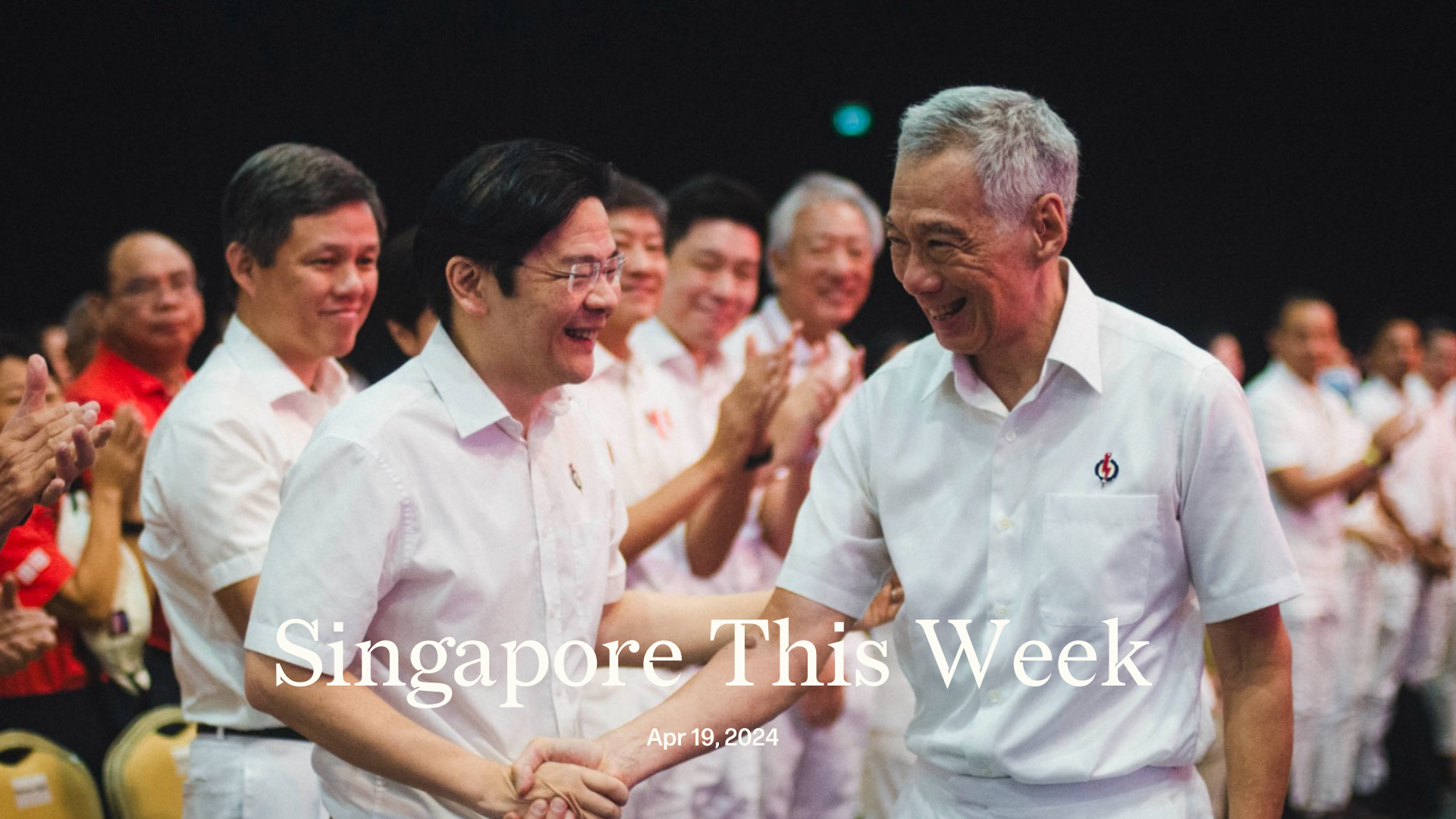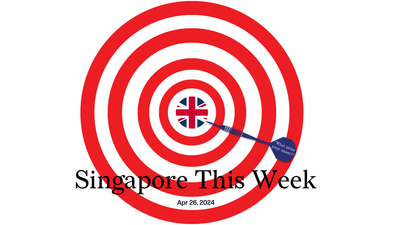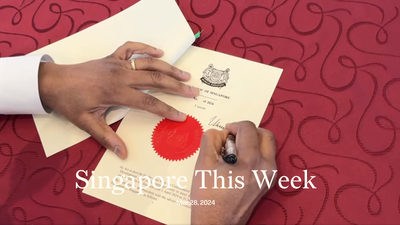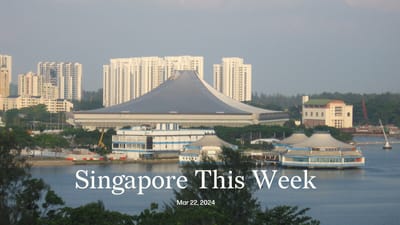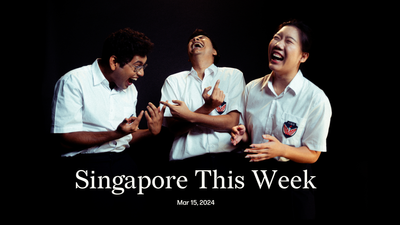Politics: The Wong time
On Monday, Singapore’s ruling People’s Action Party (PAP) finally confirmed the succession plan it’s been touting for a year. Lawrence Wong, deputy prime minister, finance minister, and leader of the fourth-generation (4G) of PAP politicians, will take over from Lee Hsien Loong, prime minister and 3G leader, on May 15th. Wong will be Singapore’s fourth prime minister and, unlike his predecessors, will have no obvious connection or obligation to the powerful Lee family. When Goh Chok Tong, Singapore’s second prime minister, took over from Lee Kuan Yew, he made the younger Lee one of two deputies, paving the way for his ascension. Assuming no scion from Singapore’s finest bloodline enters politics, the city-state is contemplating a future without a Lee at its helm.
There are many reasons why Wong is an unusual choice. He did not attend a brand name school, junior college, or undergraduate programme. His ascent up the civil service and then political ladder, by all accounts, has surprised those around him. He was not even the first choice for prime ministership. After Heng Swee Keat, the party’s original choice, dropped out, Wong became one of three in contention, alongside Chan Chun Sing, minister of education, and Ong Ye Kung, minister of health. Wong burnished his credentials during the Covid-19 pandemic, as one of two co-chairs of a multi-ministerial committee. (A tearful show of gratitude to healthcare workers was memorable.) Still, unlike his predecessors, he was not the unanimous choice of his peers. He will take over a party more fractured than it’s ever been (though still incredibly cohesive). Meanwhile, Singapore’s opposition, particularly the Workers’ Party (WP), is more formidable than it’s been since the 1960s. The PAP’s 60 percent vote share and parliamentary dominance mask an electoral fragility. Analysts say there’s an outside chance it could lose a general election (GE), for the first time since it gained power in 1959, within the next two to three cycles. Wong will lead it into the next GE, which must be called by November 2025, but which many expect to be late this year.
Given society’s evolving demands, Wong will likely have to oversee significant reforms if he’s to succeed (see next blurb). His decision, therefore, to keep Lee in his cabinet as a senior minister, is disappointing. The PAP, and Singapore, need to move out of the Lee family’s shadow—not only to allow a proper interrogation of our past, but to allow room for various visions of the future. No young Lee sniping at Wong’s heels, but an older one—and his loquacious wife—will keep hovering.
Politics: Flower Dome, not Iron Dome
If Monday’s handover script for Parliament was boringly familiar, the procession across town at Gardens by the Bay—another climate-controlled arboretum where little is left to chance—was anything but. Three Singaporeans stood on a suspension bridge 22 metres off the ground and unfurled a banner, “End SG-Israel Arms trade”. This was followed by a petition online. It was a daring manoeuvre in a city allergic to any public expression, even without considering the ban on public assemblies related to Israel’s war on Gaza. (The police said they are investigating the incident.) April 15th saw pro-Palestine activists in over 40 cities respond to the call by a group, A15 Action, to “disrupt and blockade economic logistical hubs and the flow of capital.”
Though their timing was coincidental, the political transition and the peaceful protest are philosophically linked. The protestors were taking aim at a relationship that has its genesis in the national security doctrine of Lee Kuan Yew—“Israel in a Muslim sea,” was how he once described Singapore. That the two countries’ “deep, dark, secret love affair” might ever be troubled by pro-Palestinian Singaporean activists was once unthinkable. Since the war began, the government has repeatedly been caught off guard by the desire by ordinary Singaporeans for more of a say. Wong may think that he’s inherited a winning formula, as seen by his promise not to shake up the cabinet. However, there are brewing societal tensions which, in their own way, relate to the limitations of Lee’s policies. Whether in public housing, redistribution and welfare, or inter-ethnic relations and our approach to Israel, what worked for Singapore in the 1960s-90s is increasingly found wanting, given society’s evolving expectations. The banner was a symbol that Wong may have to be a more transformative leader than he believes.
The photo circulating of the banner was poignant, with the Gardens’ greenery in the foreground offset, in the background, by the bland concrete of Marina Bay Sands, built by the late billionaire Sheldon Adelson, pro-Zionist funder of right-wing Israeli media. Between another artificial Singaporean landmark and a citadel of neoliberal capitalism, three Singaporeans raised a quiet, peaceful, and meaningful middle finger.
Some further reading: “‘You will know what to do’: Ang Swee Chai’s urgent message” by Sudhir Vadaketh, our editor-in-chief, is the last in our three-part series about Israel’s war on Gaza.
Politics: The PAP’s fourth estate
Monday’s press statement announcing the handover from Lee to Wong deployed the same robotic language used in 2004 when announcing the handover from Goh to Lee. Elsewhere, the PAP’s excessive media choreography was a marvel to behold. Its politicians coordinated long, unctuous social media posts, paying obeisance to both Lee and Wong. More than that, the party even informed mainstream media editors on which politicians’ comments were preferable to quote. (Jom received the note from several sources.) “Dear editor, You may wish to include their comments in your coverage:,” it began, before listing, with proper Leninist hierarchy, the following:
- “Heng Swee Keat, Deputy Prime Minister and Coordinating Minister for Economic Policies
- Chan Chun Sing, Minister for Education, and Minister-in-charge of the Public Service
- Desmond Lee, Minister for National Development, and Minister-in-Charge of Social Services Integration
- Grace Fu, Minister for Sustainability and the Environment, and Minister-in-charge of Trade Relations
- Edwin Tong, Minister for Culture, Community and Youth and Second Minister for Law
- Josephine Teo, Minister for Communications and Information, and Minister-in-charge of Smart Nation and Cybersecurity
- Chee Hong Tat, Minister for Transport and Second Minister for Finance
- Zaqy Mohamad, Senior Minister of State for Defence and Manpower
- Desmond Tan, Minister of State in the Prime Minister’s Office
- Alex Yam, Mayor of North West District and MP (member of Parliament) for [sic] Marsling-Yew Tee GRC
- Nadia Ahmad Samdin, MP for Ang Mo Kio GRC
- Henry Kwek, MP for Kebun Baru SMC
- Vikram Nair, MP for Sembawang GRC and GPC (Defence and Foreign Affairs) Chair
- Murali Pillai, MP for Bukit Batok SMC and GPC (Home Affairs and Law) Chair
- Liang Eng Hwa, MP for Bukit Panjang SMC and GPC (Finance and Trade and Industry) Chair”
Those who read tea leaves might wonder: are these Wong’s biggest and most reliable supporters? Are they his chosen ones? Notable absentees include Ong Ye Kung, minister of health, whose own Facebook post at 2.49pm on April 16th (so late!) mentioned only Lee and not Wong; and K Shanmugam, home affairs and law minister, whose otherwise brief, humdrum message included one bit of tantalising news about his time having worked with PM Lee: “Maybe some day, I will write about that.” Is Ong going to be Wong’s biggest internal threat? Does “Shan” have tea to spill? Well, the truth is, maybe there are neither leaves nor liquid. Perhaps politicians on the list were simply those with more time to pen flowery tributes.
Politics: Oops!…I Did It Again
Younger mainstream media reporters were recently fawning over Pritam Singh, WP chief, so he may have gotten a rude shock by an editorial this week in The Straits Times (ST). Gillian Koh of the Institute of Policy Studies wrote that “the WP said it will tilt towards the strategy of fighting to form the government at the next GE.” Singh called out the falsehood on Facebook. The WP’s medium-term goal, he said, is ensuring that the PAP loses its two-thirds supermajority. Only in Singapore, perhaps, would the leader of the opposition say that he doesn’t want to be in government. It’s because there’s a segment of non-partisan voters who might plonk for the opposition only if they’re sure they’re going to remain in opposition, as a check on the incumbent. After decades of PAP rule, in other words, the prospect of a new government might actually scare off some of the WP’s would-be voters. The WP has in the past alluded to the need to one day be ready to form the government, but it’s certainly made clear its stance ahead of the next GE. Koh, whose piece was mostly about the PAP, apologised and amended the line. ST, admirably, published a full correction, which included its initial falsehood.
All good, then? Not quite. Sleuths online pointed out that an ST opinion editor, Suling Lin, is also the wife of Marcus Loh, who’s part of the PAP team trying to win back the Sengkang group representation constituency (GRC) from the WP. Was an ST editor trying to help her husband’s cause? No, it’s probably nothing malicious, just poor journalism. Lin, one of several editors there, may not even have seen the copy. Still, it points to a problem for ST with conflicts of interest, which voters are increasingly scrutinising. Though ST has improved its coverage of the WP over the years, this incident suggests that there are, at the very least, lingering unconscious biases. For Singh, this incident may have reminded him of inherent structural challenges, and Britney Spears: “Oops, I did it again, I played with your heart, got lost in the game.”
Society: Youth sexually assaulting youth
Sexual crime is on the rise among young people in Singapore. Last year, the police arrested more than 470 youth offenders, aged 19 and below, a 30 percent increase from the previous year. The most common offence: sexual penetration of minors, where in most cases, offenders knew their victims. (It’s illegal in Singapore for those under 16 to have sex; and sex with those aged 16-18 is also a crime if there’s exploitation.) These figures were revealed at the Singapore Police Force’s annual Sexual Crimes Awareness Seminar, which aims to raise awareness about the drivers of youth sexual crimes; the criminal justice procedures for offenders and victims; as well as the resources and programmes available to support victims, at-risk youth and young offenders.
Speaking at the seminar, Sun Xueling, minister of state for home affairs (MHA), cited likely causes, including early and repeated exposure to sexually explicit materials or adult sexual activity, and inappropriate or inaccurate information about sexual behaviours and relationships. The internet was singled out as a key source of youth’s misguided schooling in sexuality. Shamala Gopalakrishnan, lead psychologist and assistant director of MHA’s Home Team Psychology Division, called it “an accessible ‘sex educator’” that has spread misinformation on sex and relationships, including through pornography. “They adopt unrealistic, harmful perceptions towards women and girls, and this can contribute to sexual offending,” she said. MHA is working with the Ministry of Education (MOE) to develop programmes to curtail sexually inappropriate attitudes and behaviours. AWARE (Association of Women for Action and Research) suggested that Singapore’s sex ed curriculum needs to cultivate “porn literacy”, and cover topics like “healthy (and unhealthy) relationships, gender-based violence and the debunking of sexist beliefs.”
Sex education has been a site of contention between conservative Singaporeans and those who want it to be less “boring” and “uptight”—that is, to go beyond the message of abstinence. In 2022, MOE sent a shocking letter to parents and guardians that said sex education “is premised on the importance of the family as the basic unit of society.” Alternatives like AWARE’s “Comprehensive Sexuality Education”—controversially suspended in 2009—and “Birds & Bees” programmes are important. After all, as one 21-year-old told TODAY, “The more you tell us not to do something, the more we want to do [it], because we were at the age to try out different things.”
Society: Dialling up the heat to tackle rat infestations
They’re discreet, full of bytes and have excellent night vision. No, not rats—cameras with thermal detection capabilities. From next week, the National Environment Agency (NEA) will deploy between four and eight cameras for each of two initial locations to detect rats via body heat in outdoor and back-lane areas. More cameras will also be rolled out to other places over the four-week testing period. “Enforcement action may be taken depending on the observations and follow-up inspections,” said the agency in a statement. Rat populations have ballooned in recent years—NEA recorded an average of 5,203 burrows last year, up from 4,163 in 2022. Factors drawing the rodents out include exposed food waste, improper trash disposal, as well as hotter and wetter weather. Data collected from the cameras will allow premise operators to improve cleaning, waste management and rat control measures. It can also be used when investigating errant food establishments who manage waste improperly.
Rats are a perennial problem for cities across the world, from New York (remember “pizza rat”?) to London to Paris. Never one to miss being in a top 10 ranking, Singapore made it onto this list of the world’s 25 “rattiest” urban places, where Bukit Batok ranked eighth with an estimated 301 rats per 100 people. Before Remy, of “Ratatouille” fame, became a poster boy, his less adorable ilk were pretty much (and still are) one of the most loathed pests on this planet. They’re feral, carry diseases like the plague, and breed rampantly. Only their ubiquitous cockroach cousins come anywhere close to being as, if not more, feared. Maybe Singaporeans, like New Yorkers, need a “rat czar”. A “maestro” who can orchestrate the eviction of these intelligent creatures once and for squeakin’ all.
Note: No rats were harmed in the writing of this blurb.
History weekly by Faris Joraimi
In 1889, Kubota Beisen, a Japanese artist, travelled to Paris to attend the Universal Exposition. The steam-powered journey took him through Asia’s busiest port-cities: Shanghai, Hong Kong, and Singapore, among others. In his characteristic style that blended Western perspective and shadow with light, brisk lines, Beisen captured scenes of local life in these places in a two-volume work, Beisen’s Travel Album. He was only in Singapore for a little over eight hours, but produced twelve captivating illustrations that document our emporium’s broad avenues, diverse peoples, and rich biodiversity. There are women in baju panjangs, selendangs, and saris, gentlemen in checked sarongs and Ottoman tarbushes, rickshaw pullers and shopkeepers. Their origins and identities are unclear, but the fabrics and postures are familiar as they move through this hard infrastructure of stone façades, street lamps and electric trams. Market-goers and gardeners share the crowded stage with livestock, sea creatures, birds and trees, suggesting how human history is entwined with that of other life forms.
The Lee Kong Chian Natural History Museum (LKCNHM) recently published a book, entitled 8½ Hours in Singapore, that uses Beisen’s Singapore drawings to discuss the city’s “co-existence with nature and its environmental changes in the late 19th century.” It is jointly authored by Kathy Poh, Jeslynn Teo and Maimon Hussin, researchers at the LKCNHM’s Biodiversity Histories team who have interpreted Beisen’s drawings to tell a history that is, in their words, “interdisciplinary”. True enough, the information in these images spans technology, fashion, architecture, social and class relations, and of course, natural sciences. Besides being a rare depiction of Singapore by a celebrated Japanese artist of the Meiji period (Beisen was honourably summoned to make drawings in the Japanese emperor’s presence), these works are also significant for likely containing the earliest visual records of a sawfish and tiger in Singapore. The book launch on March 27th was graced not only by officials from LKCNHM and the National University of Singapore, but also the Japanese ambassador. Some 135 years after his visit to our city, Kubota Beisen continues to connect spaces.
Arts: Foreigners everywhere, especially at the Venice Biennale
The 60th edition of the Venice Biennale opens tomorrow. Running till November, the marathon showcase is widely regarded as the world’s most significant contemporary art event, comprising a central International Art Exhibition and a constellation of national pavilions hosted by individual nation states, alongside independent exhibitions unfurling all across the city of canals. This Biennale also features its first-ever Latin American artistic director: Adriano Pedrosa, a Brazilian curator who’s put together a whopping 331 artists for his expansive Exhibition, “Stranieri Ovunque – Foreigners Everywhere”. Several are Singaporeans, including the late Nanyang-style pioneers Georgette Chen and Lim Mu Hue, Chua Mia Tee, a social realist painter, Charmaine Poh, Jom’s co-founder and head of visual culture and media, and Sim Chi Yin, whose artistic practice combines research and storytelling. Poh will be showing her 2021 short film “Kin”, which imagines a safe space for queer life in Singapore, and a new piece, “What’s softest in the world rushes and runs over what’s hardest in the world”, about queer parenthood in Singapore.
Over at Singapore’s pavilion, we’re faced with the relationship between art and ecological action. Multidisciplinary artist Robert Zhao Renhui has filled the space with an immersive mixed-media installation, “Trash Stratum”, a dense, trellis-like sculpture studded with screens and found objects, inviting viewers to reflect on the “complex web of human and non-human co-existence”. The pavilion was curated by Haeju Kim and commissioned by the National Arts Council (NAC), which described the Biennale as an effort to “resonate with global audiences and calls to action on pertinent issues”. Inevitably, Israel’s war on Gaza is top of the list. Thousands have co-signed the open letter by activist group Art Not Genocide Alliance (ANGA), which called for Israel’s exclusion from this Biennale: “Art does not happen in a vacuum…Any work that officially represents the state of Israel is an endorsement of its genocidal policies.” Two days ago, a sign on the shuttered pavilion read: “The artist and curators of the Israeli pavilion will open the exhibition when a ceasefire and hostage release agreement is reached.” Pedrosa has applauded the decision while ANGA called it “empty” and “opportunistic”. Ruth Patir, the Israeli artist whose work is featured in the pavilion, remains hopeful: “I believe we will open it…I believe we will.”
Arts: Blazed in, burned out? You’re not alone.
Do the work you love, they said, and you’ll never have to work a day in your life. But what if the work you love doesn’t love you back? Two upcoming gatherings acknowledge the severe and chronic burnout artists face in their Sisyphean pursuits. One is the brunch-and-breakout-session “Hustle with care” co-organised by CITRUS practices, an informal group of arts workers committed to better practices in the arts; the other is the more anarchically titled “F*ck Up Party”, a potluck dinner and karaoke social organised by Producers SG, a network for independent producers, arts managers, and self-producing artists. So if you want to scream into a mic or do a bit of “trauma bonding”, these hangouts have you covered.
In the longer-term, both groups seek to imagine new ways of working together, including how we might redistribute labour or invest in care ethics. One in three arts workers identifies as a “self-employed person” (SEP), significantly higher than the national average (less than one in five). The cancellation of live performances and loss of gig work during the pandemic was catastrophic for them, and many who left the industry then haven’t returned. Despite collective calls to end cultures of overwork and overproduction, they persist in the arts. Theatre development space Centre 42 has been tracking the total number of theatre productions staged here annually since 2017. In the pandemic year of 2020, there were 50 live shows, 27 cancelled ones that had been well in the works, and 104 digital works—a total of 181, still outstripping production in pre-pandemic years (171 in 2018, and 133 in 2017). This spike was probably due to a new slate of pandemic emergency grants put out by the National Arts Council which, in doing its best to keep artists financially afloat, directly tied financial support to creative output. This meant that artists (mostly SEPs) were constantly trying to create new digital work, monetise archival footage of previous productions, or “upskill” themselves through workshops and courses. Countering chronic burnout isn’t just about artists reorganising labour among themselves, but how funding and philanthropic models and conditions might also shift in tandem so that practising the arts in Singapore might become more sustainable. So that artists might be able to think about “creating with care”, or throwing “F*ck Yeah Parties” instead.
Disclosure: Corrie Tan, Jom’s arts editor, was part of the creation of CITRUS practices.
Tech: Bonjour Temasek
With its new Paris office, Temasek embarks on a strategic expansion in Europe and the Middle East, to the tune of S$25bn over the next five years. The move underscores a forward-looking approach to international expansion and diversification amidst a challenging geopolitical and macroeconomic environment. As Nagi Hamiyeh, the head of Europe, the Middle East, and Africa (EMEA) for Temasek, articulated, it signifies confidence in Europe’s economic recovery and potential. This is despite recent financial setbacks in some of its European holdings: Standard Chartered and Dutch payments platform Adyen have slipped from their peaks; and shares of Bayer AG plunged 51 percent in the year till March, as the healthcare and agriculture firm faces lawsuits over Monsanto, its brand of weedkiller.
Temasek’s past experience has likely led to Hamiyeh targeting a more concentrated portfolio approach with fewer, but larger expected investments in the region. Temasek will deepen engagements with the continent by partnering with members of some of the world’s wealthiest business families, such as Bernard Arnault, LVMH founder, and Francois Pinault of Kering SA, owner of Gucci and other luxury brands. Beyond financial gain, these steps are likely to yield significant social and political capital in Europe for the sovereign wealth fund. Notably, Temasek will also use the new office in Paris as its outpost for eyeing smaller, calculated moves in the fast-growing Middle Eastern markets. In the last 10 years, Temasek’s portfolio allocation to the rest of the world (excluding Asia) has grown steadily from 29 percent to 37 percent. This number is set to expand further with the strengthening of their presence in Europe and the Middle East.
Tech: Oracle doubles down on tradition of supporting education with AI training
Oracle has committed to an ambitious goal of offering free artificial intelligence (AI) training to approximately 10,000 students and professionals in Singapore. This initiative, which encompasses training in AI, cloud computing, cybersecurity, and data management by Oracle University, represents a significant stride towards fostering the skills necessary for the burgeoning digital economy. The announcement coincides with Oracle’s plans to establish a second data centre in Singapore, highlighting the strategic importance of the city-state in the tech company’s global operations and its commitment to investing in the region’s digital infrastructure and capabilities.
The move underscores the tech giant’s alignment with Singapore’s ambitious plan to expand its AI talent pool. It also speaks to Singapore’s broader attraction as a nexus for AI and technology innovation, as evidenced by significant investments and initiatives from other major tech entities like ByteDance, Google, Nvidia, and potential investments by Temasek into major AI players like OpenAI. (Aside: Sam Altman, its founder, engaged Lee in a technical discussion of AI at the Istana, according to Josephine Teo, minister for communications and information, in her tribute to the outgoing leader.) Notably, Oracle isn’t new to the education industry and is the first tech giant to operate a public high school in Redwood City, California. Design Tech High School offers curricula in wearables and robotics as well as internships and mentorships with the firm. Locally, Oracle’s long-term engagement with Singapore’s educational institutions further amplifies its role in nurturing the next generation of tech talent, reinforcing the symbiotic relationship between the evolution of the tech industry and the wider development of education pathways.
If you enjoy Jom’s work, do get a paid subscription today to support independent journalism in Singapore.

